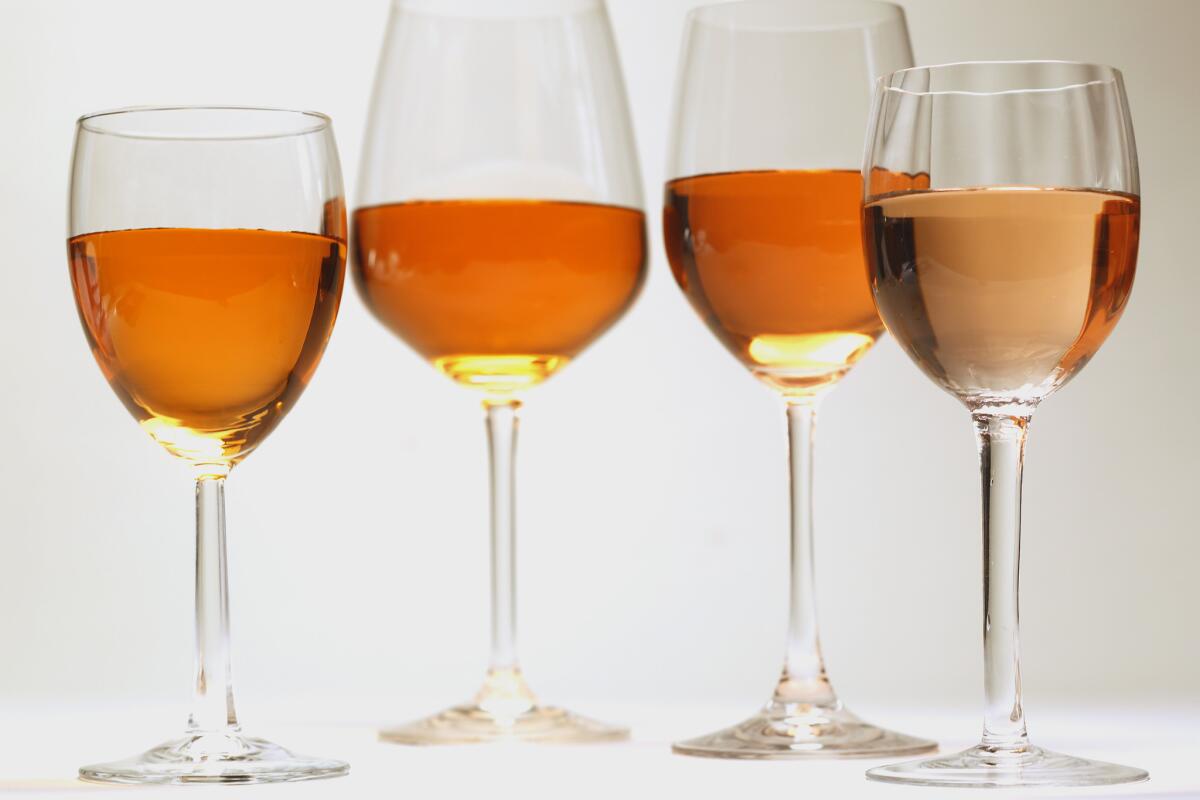Keep a bouquet of rosés on hand in the land of endless summer

- Share via
A bottle of wine blushed with pink sits on a table outside. Moisture beads the surface of the chilled bottle. As the corkscrew drills into the cork, there’s a slight squeak and then the satisfying pop as it pulls free of the bottle. The wine splashes into the glass, pink shot through with coral.
Summertime.
Rosé used to be my guilty pleasure. Serious wine drinkers dismissed the stuff out of hand, the memory of all those terrible — and extremely popular — white Zinfandels from the ‘80s marring their good sense. Most, it is true, weren’t very good — too fruity, a touch sweet, plain dull.
Not all that long ago, rosé, at least in this country, meant wine designed for those who didn’t really like wine and furthermore didn’t have a clue.
How times have changed.
Now walk into a wine store and the rosés are proudly displayed up front and in numbers that seem to grow exponentially every year. The spectrum of colors goes from pale onionskin at one end through peachy gold, pink, rose and on to coral and a deep rose just this side of red. Particularly pale examples are sometimes labeled “blush.”
White Zinfandel has pretty much slunk away into the back corner, ceding the spotlight to a new class of rosés from California, Oregon, Washington and wine regions around the world. I find old favorites mixed in with rosés from odd corners of France or Spain, or even Germany.
The French have understood and celebrated rosé all along. Those from Provence and from Tavel in the southern Rhone have long been the gold standards, though Tavel has had its ups and downs. The dry, crisp pinks are the perfect match for the French Riviera’s tapenade, aioli, bouillabaisse and grilled fish.
Bandol, the tiny appellation between Toulon and Marseilles, makes some killer rosés from Mourvèdre. Domaine Tempier’s Bandol rosé has practically been the house wine at Alice Waters’ celebrated Chez Panisse since the beginning. It’s one of my favorites too, but at nearly $40 a bottle, not a regular on my table.
I’m still drinking through my 2012 French rosés. Good thing, because 2013 has not exactly been a stellar year for rosés in France. All the more reason to discover examples from other wine regions stepping up their game with well-crafted, easy- or not-so-easy-drinking rosé. Some of the best are made only in limited quantities and will disappear from wine shops relatively quickly.
Rosés come in a variety of styles. I tend to gravitate toward those that are dry, not too fruity, crisp and aromatic. Overly fruity, flabby rosés don’t make it past the first two or three sips with me. The wine has to have some structure and grace — and a finish that entices you to take another sip. Rosés are often made from southern Rhone grapes, Pinot Noir, Mourvèdre and sometimes even Cabernet Sauvignon or Cabernet Franc.
The best strategy for finding the style you prefer is to pick up half a dozen different bottles from a trusted retailer. Throw a rosé tasting, then go back to buy more of the ones you fancy. Next, perform the same exercise at a different wine retailer. It’s going to be a long summer.
A rosé fancier once told me, “As great as they can be, you don’t want to drink them in the winter.” I beg to differ. Here in Southern California, we’ve got summer days sprinkled throughout the year. You never know when a sweltering day will pop up. And being something of a prévisionniste or forecaster, I’ve got my stash of rosé ready year round for that pop-up sweltering day.
More to Read
Eat your way across L.A.
Get our weekly Tasting Notes newsletter for reviews, news and more.
You may occasionally receive promotional content from the Los Angeles Times.









